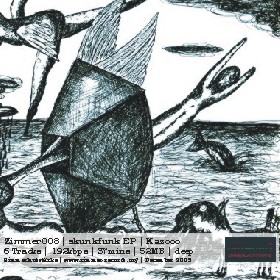Zimmer008 – kazooo – skunkfunk (Germany)
mp3, 192kbps, stereo, deep, minimal, dubtechno
008.1 – kazooo – broken cowbell
008.2 – kazooo – lefthand urinating
008.3 – kazooo – tinitus
008.4 – kazooo – eastern europe
008.5 – kazooo – skunkfunk
008.6 – kazooo – lace panties
download & stream -> archive.org
download & stream -> sonicsquirrel.net
download & stream -> last.fm
download ZIP (MP3 | 52MB)
Artwork (666px)
[by nadrealizam]
Skunks are notorious for their anal scent glands, which they can use as a defensive weapon. They are similar to, though much more developed than, the glands found in species of the Mustelidae family. Skunks have two glands, one on each side of the anus. These glands produce a mixture of sulfur-containing chemicals such as thiols, traditionally called mercaptans, which have a highly offensive smell. The odor of the fluid is strong enough to ward off bears and other potential attackers and can be difficult to remove from clothing. Muscles located next to the scent glands allow them to spray with a high degree of accuracy, as far as 3 m (10 ft). It has been confirmed by numerous studies that the smell from their anal scent glands travel less than 1 kilometer. The smell aside, the spray can cause irritation and even temporary blindness, and is sufficiently powerful to be detected by a human nose up to a mile down wind. Their chemical defense is effective, as illustrated by this extract from Charles Darwin’s Voyage of the Beagle:
We saw also a couple of Zorrillos, or skunks—odious animals, which are far from uncommon. In general appearance, the Zorrillo resembles a polecat, but it is rather larger and much thicker in proportion. Conscious of its power, it roams by day about the open plain, and fears neither dog nor man. If a dog is urged to the attack, its courage is instantly checked by a few drops of the fetid oil, which brings on violent sickness and running at the nose. Whatever is once polluted by it, is for ever useless. Azara says the smell can be perceived at a league distant; more than once, when entering the harbour of Monte Video, the wind being off shore, we have perceived the odour on board the Beagle. Certain it is, that every animal most willingly makes room for the Zorrillo.
Skunks are reluctant to use this weapon, as they carry just enough of the chemical for five or six uses – about 15 cc – and require some ten days to produce another supply. Their bold black and white coloration make their appearance memorable. It is to a skunk’s advantage to warn possible predators off without expending scent: black and white aposematic warning coloration aside, threatened skunks will go through an elaborate routine of hisses, foot-stamping, and tail-high deimatic or threat postures before resorting to spraying. Skunks usually do not spray other skunks, except among males in the mating season. If they fight over den space in autumn, they do so with teeth and claws.
Most predators of the Americas, such as wolves, foxes and badgers, seldom attack skunks, presumably out of fear of being sprayed. The exceptions are dogs, reckless predators whose attacks fail once they are sprayed, and the great horned owl. It is the skunk’s only regular predator. In one case, the remains of 57 striped skunks were found in a single owl nest.
Skunks are common in suburban areas. Frequent encounters with dogs and other domestic animals, and the release of the odor when a skunk is run over, have led to many myths about the removal of skunk odor. Due to the chemical composition of the spray, most of these household remedies are ineffective, except for remedies able to break down thiols.
Skunk spray is composed mainly of three low-molecular-weight thiol compounds, (E)-2-butene-1-thiol, 3-methyl-1-butanethiol, and 2-quinolinemethanethiol, as well as acetate thioesters of these. These compounds are detectable by the human nose at concentrations of only 10 parts per billion. //wikipedia
